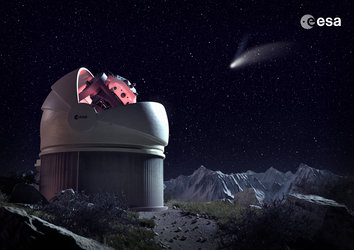

Flyeye telescope
A new, European telescope nicknamed ‘fly-eye’ splits the image into 16 smaller subimages to expand the field of view, similar to the technique exploited by a fly’s compound eye. Such fly-eyed survey telescopes provide a very large field of view: 6.7° x 6.7° or about 45 square degrees. 6.7° is about 13 times the diameter of the Moon as seen from the Earth (roughly 0.5 degrees).
In the telescope, a single mirror of 1 m equivalent aperture collects the light from the entire 6.7° x 6.7° field of view and feeds a pyramid-shaped beam splitter with 16 facets. The complete field of view is then imaged by 16 separate cameras. The red caps in the image are the covers over the 16 cameras that contain the 16 detectors. The tubes contain a set of secondary lenses.
In mid-2014, ESA signed a contract for about €1 million with a consortium led by CGS S.p.A (Italy), comprising Creotech Instruments S.A. (Poland), SC EnviroScopY SRL (Romania) and Pro Optica S.A. (Romania) for the detailed design of the advanced telescope.





